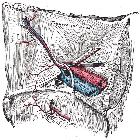Busoga hernia
 nicht verwechseln mit: Ogilvie-Syndrom
nicht verwechseln mit: Ogilvie-SyndromBusoga hernias, also known as Gill-Ogilvie hernias in Europe (alternative plural: herniae), are a variant of the direct inguinal hernia involving the conjoint tendon.
Epidemiology
Busoga herniae have been noted to occur most commonly in young, athletic men with a well-developed abdominal musculature . There is an increased incidence of Busoga hernia in Uganda .
Clinical presentation
It presents as an acute, painful lump in the inguinal/groin region, where the pain may be discordant with its small size .
Pathology
The conjoint tendon medially reinforces the posterior wall of the inguinal canal. It is protrusion here, at the medial aspect of the posterior aspect of the inguinal canal were weakening can result in herniation. Weakening in the conjoint tendon is thought to be secondary to rigorous training, with kicking, running, and sharp turns .
Treatment and prognosis
In patients with a symptomatic hernia, laparoscopic repair is ideal to prevent the risk of strangulation.
History and etymology
Busoga hernia is named due to their higher incidence in Busoga, Uganda . Notably, in the literature Busoga has been spelled incorrectly as 'Bugosa', which does not exist as a geographical location in Uganda .
See also
Siehe auch:
und weiter:

 Assoziationen und Differentialdiagnosen zu Ogilvie-Hernie:
Assoziationen und Differentialdiagnosen zu Ogilvie-Hernie:
